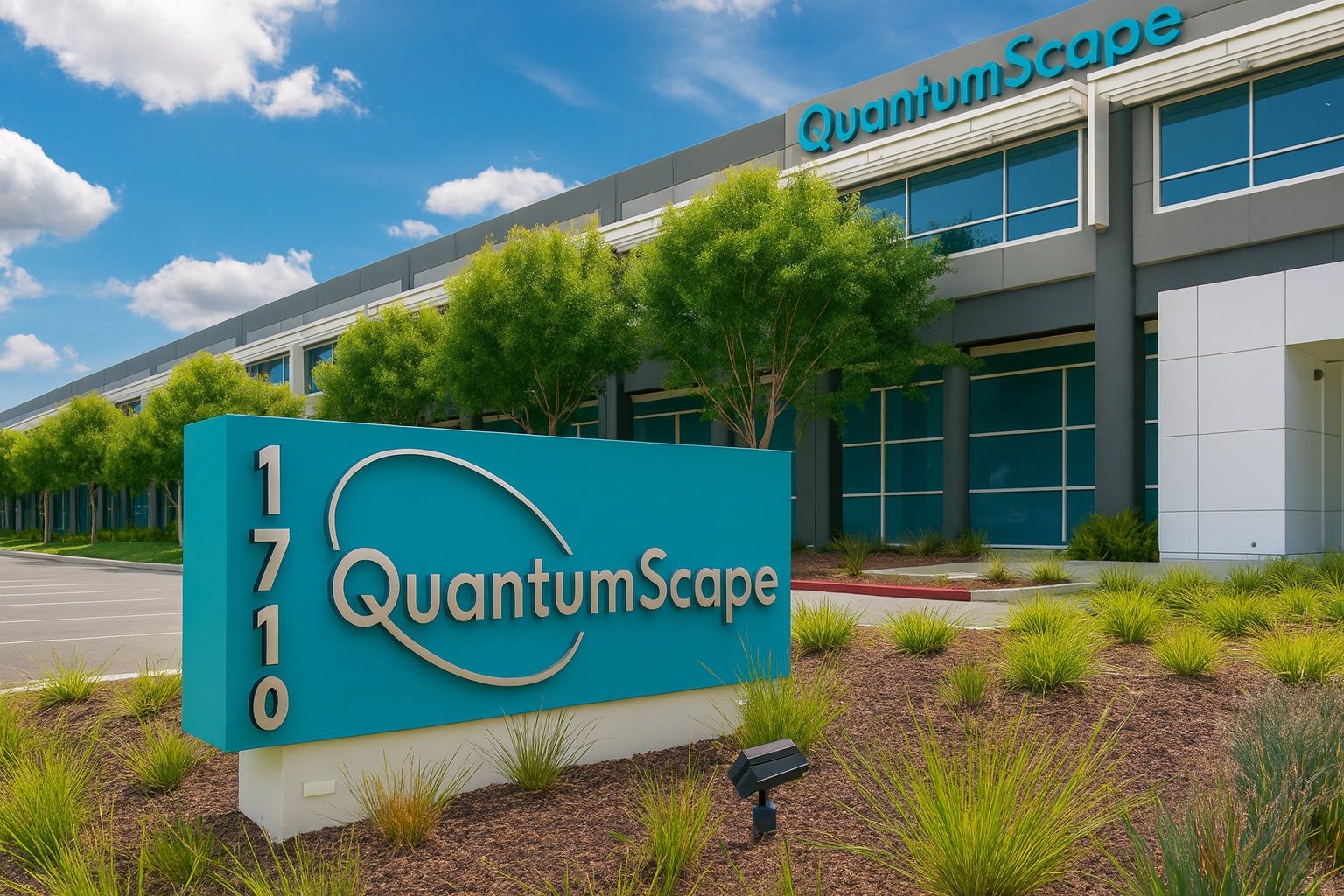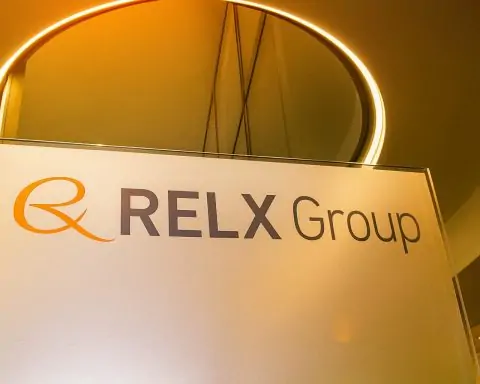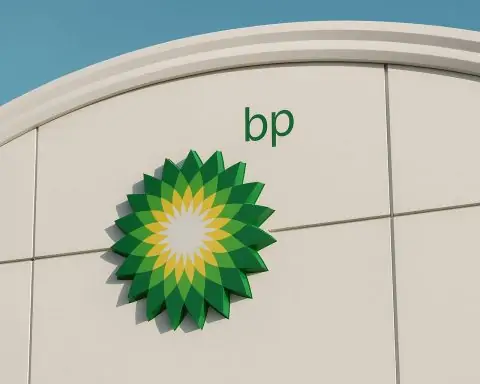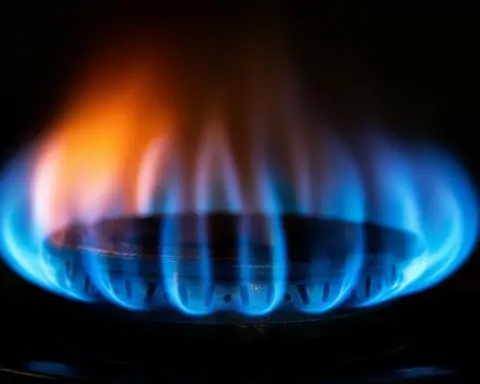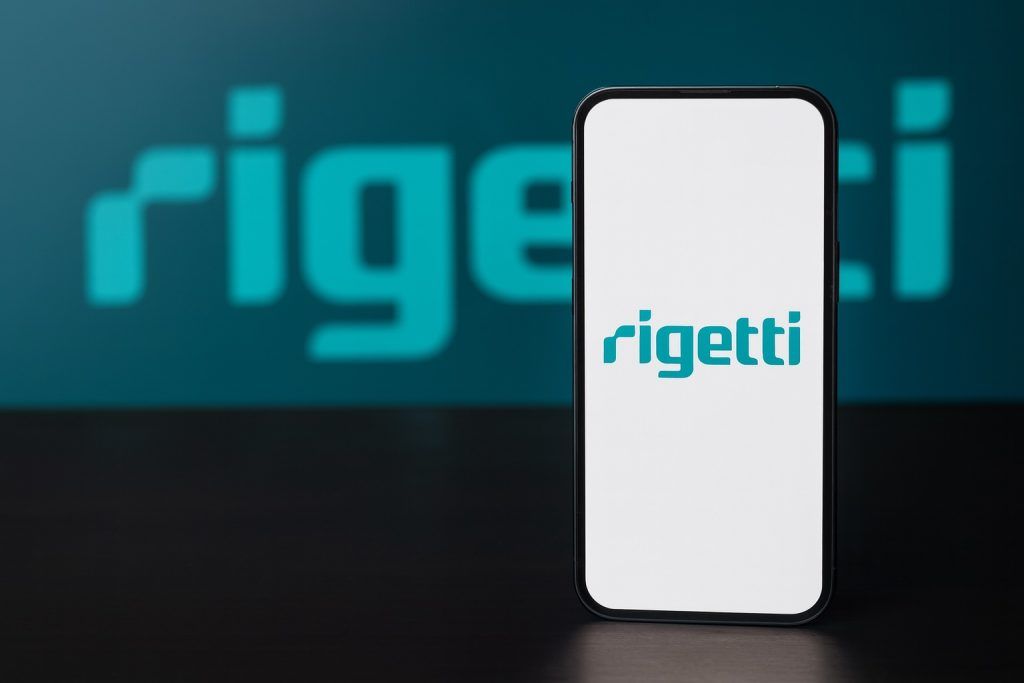- Stock Surge: QuantumScape (NYSE: QS) shares have exploded roughly +170–200% in 2025, hitting multi-year highs (~$16 by Oct. 3) and trading around $17.6 on Oct. 13 [1] [2].
- Big Partnerships: QS announced a Corning joint development deal (Sept. 30) and expanded its pact with Murata Manufacturing (Oct. 8) to mass-produce its proprietary ceramic solid-electrolyte separators [3] [4]. These partners bring heavy-duty ceramics expertise to accelerate QS’s scale-up.
- VW Funding: Volkswagen’s battery arm (PowerCo) agreed to pay ~$261 million in milestone funding over two years, extending QS’s cash runway toward 2029 [5]. VW also holds ~17% of QS and can license large volumes of QS cells.
- Tech Demo: A Ducati prototype e-motorcycle powered by QS’s cells (using the new “Cobra” separators) achieved ~844 Wh/L energy density and went from 10% to 80% charge in ~12 minutes (Sept. 2025) [6] – the first real-world demo of QS’s anode-free solid-state battery.
- Financials: QS remains pre-revenue and loss-making. In Q2 2025 it posted a GAAP net loss of ~$115 M (R&D-heavy), but holds ~$800 M in cash [7]. Cash burn is offset by partner funding; QS expects no meaningful product sales until at least 2026–2027.
- Analyst Outlook: Wall Street is skeptical. The average 12-month price target is just $5.9 (vs. ~$17.6 current), implying ~–60% downside [8]. Consensus rating is “Reduce” (6 holds, 3 sells, 0 buys). Most analysts warn QS’s ~$9+ billion market cap depends entirely on future execution.
- Industry Context: Solid-state batteries promise roughly double today’s Li‑ion energy density (~600 Wh/L) and ultra-fast charging [9]. Competing programs (e.g. Toyota ~2026 production, Samsung SDI by ~2027) mean an intense industry race [10]. Other solid-state startups (Solid Power, SES AI) have also seen stock bumps alongside QS.
- Expert Commentary: QS’s CEO Siva Sivaram hailed the progress: “we’ve crossed the threshold from possibility to reality” with the Ducati demo [11]. He added on Corning, “Corning’s world-class capabilities … makes it an ideal addition to the QS technology ecosystem” [12]. Murata’s president confirmed Murata will “leverage its strengths in ceramics technology” to help scale QS [13]. Even bullish analysts note QS’s potential: Motley Fool’s Eric Volkman argues QS “remains a buy thanks to a future that could be…very electric” [14].
With these facts in mind, let’s dive deeper into QuantumScape’s situation and outlook.
Market Rally and Key Partnerships
In late Sept–Oct 2025, a flurry of announcements sent QS stock into a frenzy. After trading flat ($12–$13) through mid-September, QS jumped 18% on Sept. 18, then another ~18% on Oct. 1, topping out at $16.49 on Oct. 3 [15]. By Oct 13 it was trading around $17.6 (up ~15% that day) [16]. This roughly 170–200% YTD gain outpaces virtually all peers (the S&P 500 is up ~14% YTD).
What drove the rally? Investors applauded new manufacturing partnerships and technology demos. On Sept. 30 QuantumScape announced a Corning joint development agreement. Corning — a leader in glass and ceramics — will co-develop high-volume processes for QS’s ceramic separator film [17] [18]. QS CEO Sivaram enthused: “Corning’s world-class capabilities in ceramics manufacturing makes it an ideal addition to the QS technology ecosystem… building the foundation for scalable production of our high-performance solid-state batteries” [19]. The next day (Oct. 1), share volume spiked as this news sank in, confirming a breakout above the $15–$16 resistance level [20].
Murata Manufacturing, the Japanese electronics giant, was next. On Oct. 8 QS expanded a ceramics deal with Murata to mass-produce its proprietary separator films [21] [22]. Murata President Norio Nakajima said Murata will “leverage its strengths in ceramics technology” to advance QS’s scaling [23]. QS’s own release noted Murata is now “an important part” of its supply chain ecosystem (via a CEO quote) [24]. Markets cheered: Analysts described the Corning and Murata moves as “de-risk[ing]” QS’s ceramic production bottleneck [25] [26]. A trading blog noted this “joint venture with Murata” sent QS stock up ~12% in one session [27].
Other partnerships and policy support fueled optimism too. Volkswagen’s PowerCo will pay $261 M in milestone fees over two years (on top of earlier commitments), ensuring QS’s San Jose pilot line gets funded [28]. This effectively extends QS’s cash runway into 2029 (vs. 2027) [29]. The U.S. government’s push to secure domestic lithium (e.g. funding Lithium Americas/Thacker Pass) also lifted battery stocks on Oct. 3 [30], since a stable supply chain bodes well for QS and peers. In short, the rally was triggered by concrete progress toward production rather than mere speculation.
Solid-State Battery Technology and Demos
QuantumScape’s core appeal is its lithium-metal solid-state battery technology. Unlike conventional Li-ion cells (which use a flammable liquid electrolyte), QS’s cells have an “anode-free” design with a solid ceramic separator [31]. When charging, lithium metal plates onto a bare copper current collector (instead of carrying a graphite anode), boosting energy density and simplifying cell construction [32]. The Cobra separator process, fully integrated in mid-2025, heats the separators ~25× faster than QS’s old method [33], enabling gigawatt-scale output. CEO Sivaram says Cobra and the Corning/Murata partnerships “will build the foundation for scalable production” of QS batteries [34] [35].
Why care? Solid-state cells could dramatically improve EV batteries. They are inherently safer (no fire-prone liquid), allow much higher energy density, and fast charging. In fact, QS’s public demos are eye-opening: the Ducati electric motorcycle at Munich’s IAA show (Sept. 2025) used QS’s latest cells. It hit about 844 Wh/L energy density (versus ~600 Wh/L typical for top Li-ion today) and charged from 10% to 80% in ~12 minutes [36] [37]. (By comparison, solid-state pioneer Toyota targets 1,000 km range/10-min charges by 2026 [38].) Volkswagen PowerCo’s CEO Frank Blome said solid-state “will redefine what’s possible” for EV performance [39]. QS’s demonstrable tech progress (anode-free cells working in a real vehicle) has turned skeptics’ heads.
Nonetheless, scaling remains unproven. All analysts stress QS must validate these lab demos in large volumes. The company is still years away from commercial sales. As one TS2 analyst put it, until production yields and costs are nailed down, QS’s stratospheric stock price is a bet on future promise [40] [41].
Financial Health and Analyst Forecasts
QuantumScape is still pre-revenue. Its latest filings show R&D burn with no product sales yet. In Q2 2025, QS spent about $123.6 M on operations and lost $114.7 M GAAP ($63 M adj. EBITDA loss) [42]. It ended June 2025 with ~$800 M in cash/securities [43] [44]. Thanks to SPAC-era funding and partner cash, QS says it has the resources to operate into 2027–2029 without new fundraising [45] [46]. In fact, the expanded VW deal ($131 M new payments) helped stretch the runway into 2029 [47] [48].
How is the stock valued? Currently around $17–18 (Oct 13, 2025), QS’s market cap is roughly $9+ billion [49] [50]. This reflects extreme optimism – QS has no product revenue yet – and Wall Street is mostly bearish. Nine published analysts average $5.88 as a 12-month target [51] [52]. That consensus implies ~–66% downside from current levels. No analyst currently has a Buy rating; the consensus is “Reduce” (three sells, six holds, zero buys) [53].
In other words, the forecast from most sell-side pros is that QS is overvalued. If execution slips, many expect a sharp pullback. A recent technical trader noted that mid-$14s had been a historical ceiling, warning of overbought conditions after the vertical climb [54]. However, bulls argue the 2025 +140–180% run-up is justified by the groundbreaking partnerships and demos (as Motley Fool’s Eric Volkman put it, there are “very good reasons for the rally,” and QS could be a “very electric” bet on the future [55]). The true test will be execution of QS’s 2026–2027 milestones (pilot production, B-sample cells to automakers, etc.).
Competition and Industry Context
QuantumScape is not alone in pursuing solid-state batteries. Major auto companies (e.g. Toyota, Nissan, Hyundai) and battery giants (Samsung SDI, Panasonic, LG Chem) all have programs aiming for late-2020s commercialization. Specialty startups like Solid Power (with BMW/Ford) and SES AI have also been racing – and saw their stocks pop when QS had breakthroughs [56] [57]. Each has a different technical approach (cathodes, electrolytes, etc.), but all face the same challenge of mass manufacturing.
Solid-state proponents claim vast benefits: longer EV range (~600 miles on a charge), super-fast charging (10–15 min 10–80%), and thousands of cycle life [58]. If QS achieves even half of that, it could undercut existing Li‑ion batteries on cost and performance. Industry analyses project the global solid-state market growing from ~$100 M in 2024 to over $1 B by 2030 at 40% CAGR. However, every competitor’s progress is needed to meet automakers’ aggressive timelines. Toyota, for example, still plans a 2026–28 start; VW’s PowerCo has already built factories in Germany anticipating QS cells; and Chinese firms are reportedly working on their own SSB efforts.
Murata’s involvement highlights the wider ecosystem shift. Murata is famous for capacitors, but its ceramics expertise is now being tapped. Its stock has rallied as Murata pivots to next-gen batteries. Simply Wall St notes Murata’s shares are up ~31% over the past quarter (outperforming peers) [59]. In short, solid-state batteries are now a focus for both battery and materials companies worldwide, and QS’s “demonstration effect” has lit a fire under the whole sector.
Experts’ Take and Outlook
Industry and market experts are cautiously optimistic. QS executives highlight the technology edge. As noted, QS CEO Siva Sivaram celebrated crossing “the threshold from possibility to reality” [60]. VW’s Thomas Schmall (PowerCo boss) has called QS’s anode-free design a “game changer.” Murata’s Nakajima and QS’s Siva emphasize the importance of teaming up and achieving high-volume production [61].
Analysts and commentators stress the high risk/high reward nature. “It’s a marathon, not a sprint,” one research note cautioned, reminding investors of QS’s history (post-SPAC highs at $130+ in 2021 and a steep crash thereafter [62]). True believers focus on the partnerships: WSJ and tech media describe Corning and VW backing as validation. Even subscription services are now raising QS from “Hold” to “Buy,” saying the tech is “de-risked” by these deals [63]. On the other hand, bears note QS has no earnings; any delay could send the stock plummeting.
Forecast-wise, barring further surprises, many strategists expect QS to remain volatile and tied to milestones. Consensus price targets imply downside, but a few bulls argue long-term gains could be huge if solid-state truly revolutionizes EVs. MarketBeat data shows a wide range: high targets up to ~$11 [64], lows at ~$2.50. Some traders are using QS options (Yahoo Finance reported an unusually busy options market around the Murata deal). For now, QS’s performance is riding the wave of recent news.
Conclusion: Revolution or Risk?
As of mid-October 2025, QuantumScape stands at a crossroads. The technology and its backers are suddenly in the spotlight. If it can translate its breakthroughs into reliable production, QS could deliver on its promise of a “solid-state revolution.” But the road is long: investors remember QS’s wild 2021 highs and dramatic fall. The next few quarters will reveal whether the hype is warranted or if QS’s lofty valuation proves premature.
In summary, every new announcement matters. The Corning and Murata alliances have substantially de‑risked QS’s path, in the eyes of many. Yet QS will have to meet production milestones in 2026–2027 to earn its keep. Meanwhile, competitors race on all fronts, and analysts will be quick to adjust forecasts based on QS’s progress. As Motley Fool’s Volkman said, QS has shined so far, but it still must earn its gains. For the public and retail investors, the situation is a classic “moonshot”: very high risk, but with the potential to transform EV batteries if successful [65] [66].
Sources: Recent analyses and news reports have been used to compile this report, including TechStock² (TS2.tech) coverage [67] [68], Seeking Alpha commentary [69], CarbonCredits/Finance media [70], Electrek [71], and financial data from MarketBeat [72] [73]. These are supplemented by expert quotes and filings as cited. All facts are accurate as of Oct. 13, 2025.
References
1. ts2.tech, 2. www.marketbeat.com, 3. electrek.co, 4. ts2.tech, 5. ts2.tech, 6. ts2.tech, 7. ts2.tech, 8. www.marketbeat.com, 9. ts2.tech, 10. ts2.tech, 11. ts2.tech, 12. carboncredits.com, 13. ts2.tech, 14. ts2.tech, 15. ts2.tech, 16. www.marketbeat.com, 17. electrek.co, 18. ts2.tech, 19. carboncredits.com, 20. ts2.tech, 21. ts2.tech, 22. ts2.tech, 23. ts2.tech, 24. ts2.tech, 25. seekingalpha.com, 26. ts2.tech, 27. stockstotrade.com, 28. ts2.tech, 29. ts2.tech, 30. ts2.tech, 31. ts2.tech, 32. ts2.tech, 33. ts2.tech, 34. ts2.tech, 35. carboncredits.com, 36. ts2.tech, 37. ts2.tech, 38. ts2.tech, 39. ts2.tech, 40. ts2.tech, 41. ts2.tech, 42. ts2.tech, 43. ts2.tech, 44. ts2.tech, 45. ts2.tech, 46. ts2.tech, 47. ts2.tech, 48. ts2.tech, 49. ts2.tech, 50. ts2.tech, 51. www.marketbeat.com, 52. ts2.tech, 53. www.marketbeat.com, 54. ts2.tech, 55. ts2.tech, 56. ts2.tech, 57. ts2.tech, 58. ts2.tech, 59. simplywall.st, 60. ts2.tech, 61. ts2.tech, 62. ts2.tech, 63. seekingalpha.com, 64. ts2.tech, 65. ts2.tech, 66. carboncredits.com, 67. ts2.tech, 68. ts2.tech, 69. seekingalpha.com, 70. carboncredits.com, 71. electrek.co, 72. www.marketbeat.com, 73. www.marketbeat.com
